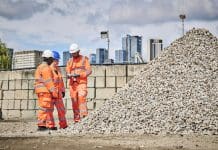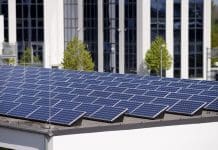Johanna Pirinen, SVP of Sustainability at Stora Enso, explores why shifting the focus to the embodied carbon of buildings is vital in helping the construction industry to decarbonise in the face of a worsening climate crisis and make more sustainable design choices
Navigating the intricate world of architecture and construction is akin to solving a complex puzzle. Across the years, it has evolved, embracing regional nuances, stylistic trends, and contemporary needs. In the UK, the buildings vary widely, from Edwardian townhouses to sleek office blocks. But like solving a puzzle, which is the more environmentally sustainable choice: a neglected Victorian schoolhouse, or a new energy-efficient concrete building?
At first glance, the new build, equipped with double-glazing and integrated insulation, seems like the better choice. Yet, when examining the overall environmental impact of erecting a new structure, it’s possible that the older building emerges as the more sustainable option due to the carbon emissions released during construction. This holistic approach requires evaluating not just operational carbon, but also embodied carbon – the often forgotten piece in the carbon puzzle.
Directing focus on embodied carbon of buildings
Desires to accelerate industry-wide decarbonisation have led to an initial focus on the operational carbon emissions of buildings. Mainly released from heating and lighting, these are the emissions which are released when a building is in use. With operational carbon accounting for 27% of global greenhouse gas (GHG) emissions, it is a valid target for sustainability efforts.
Though reducing the operational carbon of buildings is undeniably crucial, directing attention towards embodied carbon – the carbon emitted from producing building materials and the construction process – allows us to make more well-rounded decisions encompassing sustainability. And with buildings becoming more and more energy efficient and the grid increasingly decarbonising, the significance of embodied carbon emissions rises. This expanded focus brings particular importance to the materials with which society builds.
A science-based approach to emissions transparency
For many construction companies and developers, the first step to limiting their carbon emissions is taken through broadening their knowledge; it’s widely accepted that education is integral to achieving sustainability targets, and it’s no different in construction. For some leading developers, architects/engineers and contractors, this begins with looking closely at the Environmental Product Declarations (EPDs) – which contain independently verified information on a given product’s environmental impacts – and calculating the possible emissions released from constructing a given building.
With EPDs, it’s possible to use that data to integrate embodied carbon into how a building is valued: it’s not just about the cost in pounds sterling, but in carbon emissions. The level of carbon emissions can be monetised in terms of a price premium that a tenant or investor might be willing to pay for a low-carbon building, and in terms of a low-carbon building being more ready for future legislative and market demands on the building sector. By opening both eyes to the carbon footprint tied to our creations, we open the door to a new era of accountability and conscious decision-making.
This can inform structural decisions. Concrete alone is a hugely carbon-intensive material, responsible for roughly 8% of global GHG emissions. This knowledge, along with life cycle analyses (LCAs) of a building’s environmental impacts and innovative technologies now being adopted like digital models, mean that we can begin to make smarter, wiser, and more sustainable choices.
LCAs have become an important tool for building sector stakeholders, with applications from early design through to construction and even renovation projects. France, Sweden, Denmark, and the Netherlands are increasingly making embodied carbon impact assessments a prerequisite for building permits. Taking this further, in the EU, the building energy performance certificates necessary for property transactions and construction may soon require an LCA study.
Through this science-based approach to transparency in the sector, we can begin to visualise designs that support the use of renewable and less emissions-intensive materials.
Timber – the triumph of climate resilient construction
One of these more climate-smart materials is wood – specifically, engineered mass timber. Of course, that’s not to say there aren’t other such materials out there. Green steel is claimed as a viable, future alternative, however, timber is already available and growing in forests as we speak.
Mass timber brings with it a vast array of environmentally sustainable benefits. Its lightweight durability means that you can deliver a higher volume to site with a single delivery, saving on emissions across transportation. Compound this with the benefits of mass timber being prefabricated in factories: a mass timber building kit can be erected in weeks – or less! This means that workers need not be on site for as long, reducing construction timelines whilst potentially increasing profit margins. Most importantly, prefabricated elements support increased worker safety, as more work is performed in controlled factory conditions versus the project site uncertainties of weather and much else.
Not to mention timber’s inherent sustainability strength. Trees remove CO2 during their growth, with the carbon stored in the wood remaining sequestered within the building’s structure for its lifespan. Utilising biogenic materials with this high carbon sequestration capability can turn a building from a source of carbon emissions to something positive – a means of carbon storage. Even more, wood substitutes for high-emission conventional building materials. Thus, wood can be a powerful means of contributing to sustainability and climate mitigation efforts.
Placing embodied carbon of buildings at the centre of future sustainable cities
Change is underway at both macro and micro levels. In the UK, the Government’s recently published ‘Timber in construction roadmap’ is aimed at expanding the timber construction market. Additionally, forward-thinking building sector organisations – including Stora Enso – are advocating for the Government to take the necessary step of integrating embodied emissions into building regulations through the Part Z initiative. On a more local scale, the UK is steering the trajectory of urban development in greater London for the next quarter-century through LCAs, as part of the 2021 London Plan.
Sustainable building demands a shift from conventional norms. Embracing transparency, education, innovative tools, and a holistic view of carbon emissions empowers smarter decision-making for a sustainable future. Embodied carbon of buildings must now be the center piece of design. Only then can we solve the carbon puzzle of tomorrow’s sustainable cities.













